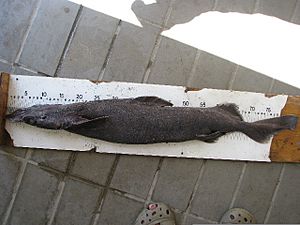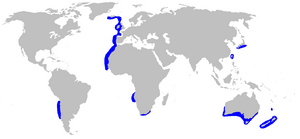Birdbeak dogfish facts for kids
The birdbeak dogfish (Deania calcea) is a type of shark that belongs to the Centrophoridae family. You can find this shark in different parts of the world's oceans. It lives in the Pacific Ocean near Honshū, Japan, southern Australia, New Zealand, and Chile. It also lives in the Atlantic Ocean, from Iceland all the way south to the Cape of Good Hope in Africa.
Quick facts for kids Birdbeak dogfish |
|
|---|---|
 |
|
| Drawing by Bideault | |
 |
|
| Conservation status | |
| Scientific classification | |
| Genus: |
Deania
|
| Species: |
calcea
|
 |
|
| Range of birdbeak dogfish (in blue) | |
Contents
What Does It Look Like?
The birdbeak dogfish has a very unique look. It has a long, thin snout that looks a bit like a bird's beak, which is how it got its name!
- It does not have an anal fin.
- It has two long, low dorsal fins on its back, and these fins have spines with grooves.
- Its pectoral fins, which are like its side fins, are small and shaped like rectangles.
- Its skin is covered in tiny, pitchfork-shaped denticles. These are like tiny teeth that help protect its skin.
Where Does It Live?
This shark is a deep-sea creature. It lives in the ocean at depths between 73 meters (about 240 feet) and 1,450 meters (about 4,757 feet). That's very deep!
What Does It Eat?
The birdbeak dogfish is a predator. It hunts for its food in the deep ocean. Its diet mainly includes:
How Does It Have Babies?
The birdbeak dogfish is an ovoviviparous animal. This means that the mother carries her eggs inside her body until the babies are ready to hatch and be born. She can have up to 12 pups (baby sharks) in one litter.
Scientists have studied how these sharks reproduce. They found that pregnant mothers can pass certain things to their developing babies while they are still inside. This is a special way for the mother to support her pups before they are born.
Is It Endangered?
In June 2018, the Department of Conservation in New Zealand looked at the birdbeak dogfish population. They decided to classify it as "Not Threatened" under the New Zealand Threat Classification System. This means that, for now, there are enough of these sharks, and they are not at high risk of disappearing.
See also
- In Spanish: Tollo pajarito para niños


